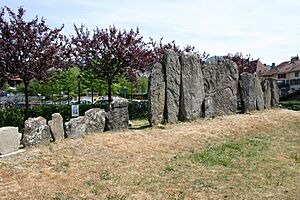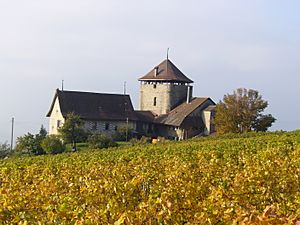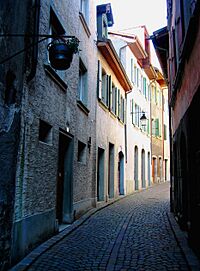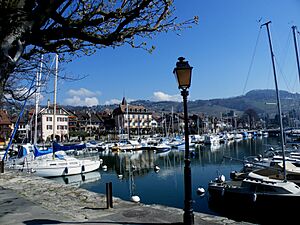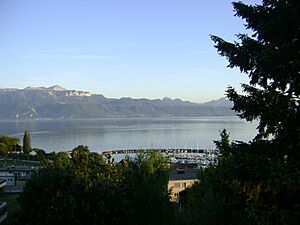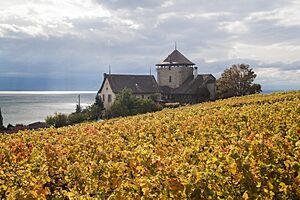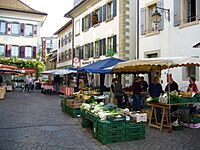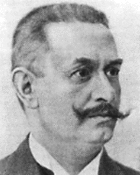Lutry facts for kids
Quick facts for kids
Lutry
|
||
|---|---|---|

Lutry village
|
||
|
||
| Country | Switzerland | |
| Canton | Vaud | |
| District | Lavaux-Oron | |
| Area | ||
| • Total | 8.46 km2 (3.27 sq mi) | |
| Elevation | 373 m (1,224 ft) | |
| Population
(Dec 2020 )
|
||
| • Total | 10,459 | |
| • Density | 1,236.3/km2 (3,202.0/sq mi) | |
| Demonym(s) | Les Lutryens/Nickname: "Les Singes" (English: Monkeys) | |
| Postal code |
1095
|
|
| Localities | Savuit, Corsy | |
| Surrounded by | Savigny, Villette, Paudex, Belmont-sur-Lausanne | |
| Twin towns | Sigriswil (Switzerland) | |
Lutry is a lovely town in Switzerland. It's located in the Vaud area, near Lake Geneva. Lutry is part of the Lavaux region. This area is famous for its beautiful vineyards. It is even a UNESCO World Heritage site.
Contents
History of Lutry
Lutry has a long and interesting past. It was first mentioned in old writings in the year 908. Back then, it was called Lustraco villam.
Ancient Times
Long ago, people lived in the Lutry area. In the 1800s, ancient graves were found. These graves held stone boxes. Inside were tools made of flint and shell necklaces. These finds tell us about the people who lived here thousands of years ago.
In 1984, something amazing was found. Workers discovered 24 tall standing stones. These stones are called menhirs. Many of them were put back in their original spots. The largest stones are about 2 to 4 meters tall. Some smaller stones form a curve. These stones are very old, from the Stone Age or early Bronze Age. One stone has special carvings. These carvings look like X-shapes and zigzags. Their meaning is still a mystery.
The Roman Empire also had settlements here. Traces of Roman buildings have been found. These include old bricks, walls, and even parts of an aqueduct.
Medieval Lutry
In the 11th century, a tower was built in Crêt-Bernard. This tower helped control the area. Later, the Bishop of Lausanne owned Lutry. A Benedictine priory (a type of monastery) was founded around the year 1025. This priory grew and became very important. It had power over Lutry and nearby villages.
The town of Lutry began to grow around the priory. In the early 1200s, a circular wall was built around the town. This wall had a square tower. This tower was called the Tour de l'Eveque. Later, a second wall was built. This helped protect more parts of the town.
People started growing vineyards around Lutry. This became a very important activity. The main church, Saint-Martin, was built in the 1200s. It was rebuilt after a fire and later restored.
Later History
In 1536, Lutry became part of Bern. This was when the Protestant Reformation happened. The priory was closed. Lutry was then ruled by a council.
In 1798, Lutry joined a revolution against Bern. It became part of a new district. In the 1800s, Lutry and Savigny became separate towns.
Growing grapes for wine became Lutry's main income. A harbor was built in the 1830s. This helped connect the town to Lake Geneva. Train stations opened in the 1860s. A tram line connected Lutry to Lausanne in 1896.
Around the 1900s, a plant disease called phylloxera hurt the vineyards. This caused money problems. But Lutry kept growing. Many small and medium businesses started. Since the 1960s, Lutry has become a popular place to live. It is now part of the larger Lausanne city area. A new port was built in 1998.
Geography
Lutry covers an area of about 8.45 square kilometers. A large part of this land, about 43.4%, is used for farming. Forests cover about 20% of the area. The rest of the land has buildings, roads, or is water.
Lutry is built on terraces. These terraces are between Lake Geneva and the Jorat region. The town includes the main village of Lutry. It also has many smaller areas called hamlets. Some of these are Curtinaux, Savuit, and Corsy. Lutry shares borders with other towns like Paudex and Savigny.
Coat of Arms
The coat of arms for Lutry is very simple. It is split into two parts. The top part is red, and the bottom part is silver (or white).
People of Lutry
Lutry has a population of about 8,443 people. Many people from other countries live here too. Most people in Lutry speak French. German is the second most common language. English is the third.
In 2000, about 19.8% of the people living in Lutry were born there. Many others were born in the same canton (area). Some people were born in other parts of Switzerland or outside of Switzerland.
Lutry has many different types of homes. Most are single-family houses. There are also multi-family buildings. Many apartments have three rooms. Most apartments are lived in all the time.
Important Buildings and Sites
Lutry has several important historical sites. These are protected as national heritage sites.
- Lutry Castle is one of them. It was built in the 1400s and 1500s. It was home to the Bishop's representative.
- The Swiss Reformed Church of Saint-Martin is also very old. It was built on the site of an even older church. Parts of the church date back to 1260. The church tower was built in 1544. Inside, you can see beautiful paintings. These were done by an artist named Humbert Mareschet in 1577.
- The Lavaux Vineyard Terraces are also a protected site. They are part of the UNESCO World Heritage Site.
Economy
Lutry has a strong economy. Many people work in different areas. Some work in farming, like growing grapes. Others work in factories or construction. A large number of people work in the service industry. This includes shops, restaurants, and hotels. Many people also work in healthcare and education.
Lutry is a place where more people leave for work than come in. This means many residents travel to other towns for their jobs. Most people use a private car to get to work. Some also use public transportation.
Religion
Many people in Lutry are Christian. About 33% are Roman Catholic. About 42% belong to the Swiss Reformed Church. There are also people of other faiths living in Lutry. Some people do not belong to any church.
Education
Education is important in Lutry. Many people have finished high school. A good number have also gone on to college or university.
The schools in Lutry serve many students. There are pre-school programs for young children. Students attend primary school for four years. Then they go to lower secondary school for six years. Some students are also home-schooled.
Transportation
Lutry has good transportation links. It has three train stations. These stations connect Lutry to other cities like Lausanne and Bern. There are also several bus lines. These buses help people travel within Lutry and to nearby towns.
Notable People
Many interesting people have been connected to Lutry.
People Born in Lutry
- Victor Ruffy (1823–1869): A Swiss politician who served on the Federal Council.
- Eugène Ruffy (1854–1919): Another Swiss politician, also on the Swiss Federal Council.
People Who Died in Lutry
- Frederick, Burgrave of Dohna (1621–1688): A German nobleman and governor.
- Edmond Jaloux (1878–1949): A French writer and critic.
- Vince Taylor (1939–1991): A British rock and roll singer.
Images for kids
See also
 In Spanish: Lutry para niños
In Spanish: Lutry para niños





